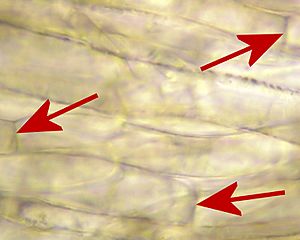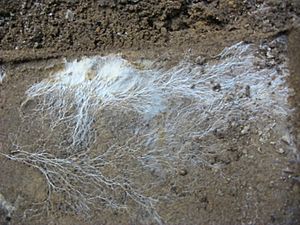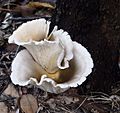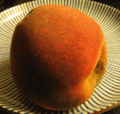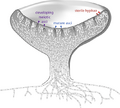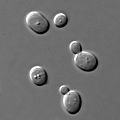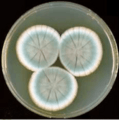Fungus facts for kids
Quick facts for kids Fungi |
|
|---|---|
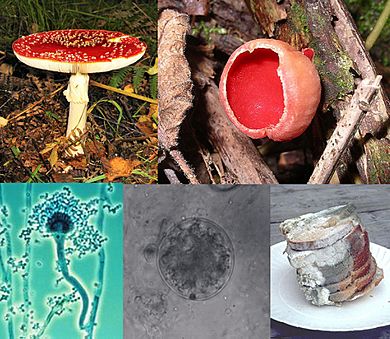 |
|
Clockwise from top left:
|
|
| Scientific classification |
|
| (unranked): | Opisthokonta |
| (unranked): | Holomycota |
| (unranked): | Zoosporia |
| Kingdom: | Fungi |
| Subkingdoms/Phyla/Subphyla | |
Dikarya (inc. Deuteromycota) Subphyla incertae sedis
|
|
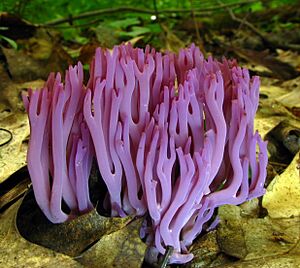
A fungus (plural: fungi) is a type of living organism. This group includes yeasts, moulds, and mushrooms. Fungi can be tiny, single-celled organisms or larger, multicellular bodies. They are a separate kingdom of living things, different from animals and plants.
Fungi have cells with nuclei. Their cell walls are made of chitin. This is different from plant cell walls, which are made of cellulose. These differences show that fungi are a unique group of organisms. They all share a common ancestor.
Most fungi get their food by being saprophytic. This means they break down dead organic matter around them and use it as food. This process is very important for recycling nutrients in nature.
Contents
How Fungi are Built
Fungi Reproduction
Fungi can reproduce in two ways: sexually and asexually. Some fungi grow mushrooms, which are like their "fruiting bodies." Under the mushroom cap, there are gills. These gills hold tiny spores that spread out. These spores can then grow into new fungi.
Other fungi use a special case called a sporangium to make spores. These spores can be made without a partner (asexually) or with a partner (sexually).
Fungi can be single-celled, like yeast, or have many cells, like mushrooms. Yeast reproduces by simply dividing into two, a process called budding.
Mycelium
The mycelium is the main body of a fungus. It's the part that isn't used for reproduction. You usually find it underground or inside other things, like wood. It's made up of many tiny threads called hyphae.
Hyphae
Hyphae look like thin threads or tiny rootlets. They can form a very thick, woven mat. Fungi use these hyphae to take in nutrients from their surroundings.
Fungi Living Together (Symbiosis)
Symbiosis means different organisms living closely together and helping each other.
- Lichens: These are a partnership between a fungus and an alga or bacterium. The algal cells live inside the fungus. Together, they form a new, mat-like life-form that can grow on rocks and other surfaces. About 20% of all fungi form lichens.
- Mycorrhiza: This is when a fungus lives inside the roots of plants. Most trees and many crop plants have mycorrhizal roots. Both the fungus and the plant benefit from this arrangement.
Fungi and Health
Some fungi can cause diseases in crops, which can harm our food supply. Others can cause serious diseases in humans. It's very important to know that some mushrooms are extremely poisonous. You should never eat a mushroom you find in the wild unless an expert tells you it's safe.
How Fungi are Used
Fungi are very useful to humans in many ways:
- Food: Many types of edible mushrooms are eaten by people all over the world. Certain types of cheese, like blue cheese, need a special fungus to be added. This fungus gives the cheese its unique flavor and texture.
- Medicine: In modern times, some fungi have become a source of antibiotics. For example, the famous antibiotic Penicillin comes from a fungus. Fungi naturally produce these antibiotics to protect themselves from bacteria.
Related pages
Images for kids
-
Fungal hyphae cells
- Hyphal wall
- Septum
- Mitochondrion
- Vacuole
- Ergosterol crystal
- Ribosome
- Nucleus
- Endoplasmic reticulum
- Lipid body
- Plasma membrane
- Spitzenkörper
- Golgi apparatus
-
Bracket fungi on a tree stump
-
An environmental isolate of Penicillium
-
Arbuscular mycorrhiza seen under microscope. Flax root cortical cells containing paired arbuscules.
-
The dark filaments are hyphae of the endophytic fungus Epichloë coenophiala in the intercellular spaces of tall fescue leaf sheath tissue
-
The lichen Lobaria pulmonaria, a symbiosis of fungal, algal, and cyanobacterial species
-
Ergotamine, a major mycotoxin produced by Claviceps species, which if ingested can cause gangrene, convulsions, and hallucinations
-
Saccharomyces cerevisiae cells shown with DIC microscopy
-
A selection of edible mushrooms eaten in Asia
-
Stilton cheese veined with Penicillium roqueforti
-
Amanita phalloides accounts for the majority of fatal mushroom poisonings worldwide. It sometimes lacks the greenish color seen here.
See also
 In Spanish: Fungi para niños
In Spanish: Fungi para niños


